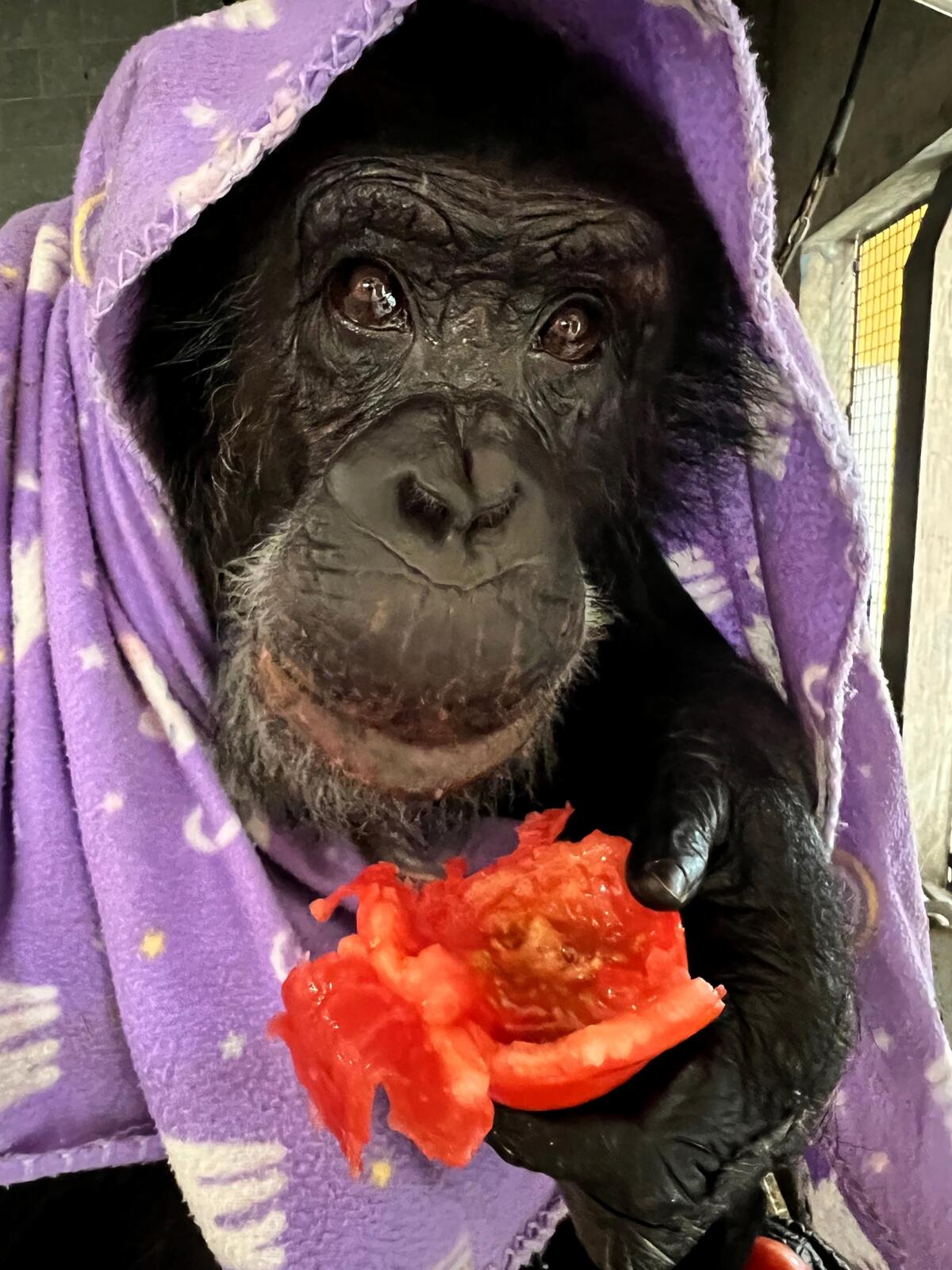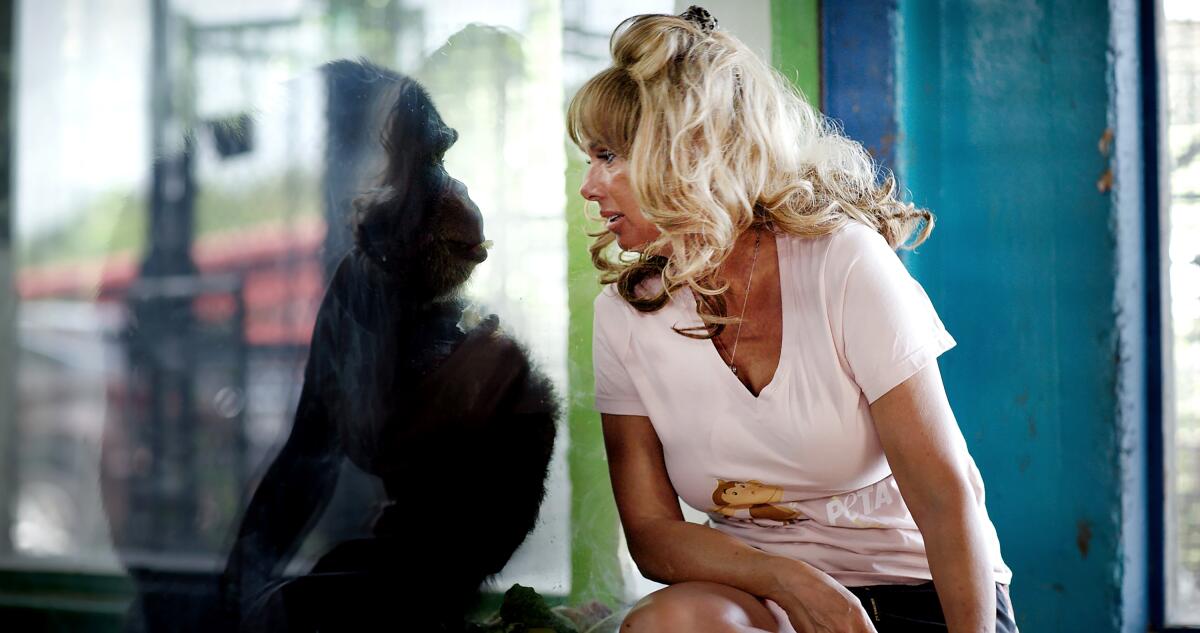After being cloistered in a basement cage for nearly a year, Tonka just wanted to be outside. Though caretakers had set up a cozy space filled with hammocks and blankets for the chimpanzee, upon arrival at his new home — an ape sanctuary on Florida’s Treasure Coast — he eschewed this private room. Instead, he wandered out into the rain and sat still, letting the water drench his body.
It’s been just over two years since Tonka arrived at Save the Chimps, a 150-acre parcel of protected land where 222 apes born in captivity have come to live out their retirement. As documented in the finale of “Chimp Crazy,” the four-episode series that wraps Sunday on HBO, Tonka was sent to the Fort Pierce, Fla., sanctuary after PETA discovered his owner had been hiding him in the bowels of her Missouri home.
The animal rights organization was alerted to Tonka’s whereabouts by the “Chimp Crazy” producers, who feared Tonia Haddix was going to euthanize the ape. Haddix told the cameras that her local veterinarian had diagnosed Tonka with congestive heart failure. But when the animal was seized from Haddix’s home by federal marshals on June 5, 2022, Save the Chimps veterinarians found he did not have any serious medical issues. He was overweight — McDonald’s Happy Meals were a regular part of his diet — and pale from being indoors, but he was declared healthy enough to make the 23-hour van ride from Missouri to Florida.

Tonka eating a tomato at the Save the Chimps sanctuary.
(Melissa Simbrat)
In the docuseries, Haddix continually expresses fear that Tonka will not thrive living among other chimpanzees. This was, after all, an animal she referred to as a “humanzee” — an ape who had spent his youth performing in Hollywood films like “Buddy” and “George of the Jungle.” Later, at the Missouri Primate Foundation, he lived in a cage alongside other chimps but interacted more with the humans who fed him Powerade, french fries and doughnuts.
Tonka’s caretakers at the Florida sanctuary, however, say he’s adapted well to living with his own kind.
“It’s amazing how well Tonka is doing,” says Ana Paula Tavares, CEO of Save the Chimps. “When the chimps first get here, they may be drawn to humans at first. But given the opportunity to be among others like themselves, they continuously prefer and end up choosing being around other chimpanzees.”
When he arrived, Tonka was put into quarantine for 60 days. During that period, the nonprofit’s primatologists observed his behavior to determine which chimp family group would be best to slowly integrate him into. Of the dozen island habitats on the property, the scientists settled on Doug’s Island, a 3-acre space with rolling hills, climbing structures and 16 other chimps.
The sanctuary’s aim is to “provide the chimps a life as close to what they would have had in the wild as possible,” Tavares says. That means allowing them the self-determination to wander where they please and placing them in large social groups where they develop hierarchical societies.
Tonka has not shown much interest in getting involved in the rankings of the family group, says Tavares. But he has developed deep friendships with two other chimps, Jake and Cayleb — the latter of whom has since been discovered to be Tonka’s biological son.
Tonka with Cayleb, his biological son.
“We had no idea before that the two of them were father and son, but seeing them jump next to each other is just the most beautiful thing. It’s amazing how close they are,” she says.
Another of Tonka’s offspring, Lisa Marie — she was the pet of an Elvis impersonator — lives on a different island at the sanctuary. Because Tonka was owned by a chimpanzee breeder, Tavares suspects he has numerous children; his paternal relationship to the two apes at Save the Chimps was established through information gathered from past breeders.
All of the male apes at the sanctuary receive vasectomies, but that does not preclude them from copulating.
“I must tell you, he’s very interested in the females. Tonka is quite a ladies’ man,” Tavares says with a laugh.
Tonka running with a fellow chimp named Jacob at the sanctuary.
Otherwise, Tonka spends his days engaging in enrichment activities that have been specifically designed by the on-site primatologists to stimulate the chimps physically, cognitively and emotionally. They paint, play with bubbles and forage for food like frozen strawberries, string beans and heads of lettuce.
The entire population at Save the Chimps goes through 2,500 pounds of food a day, prepared by Jimmy Buffett’s former chef. They eat a vegan diet and occasional healthy treats, like watermelons on the Fourth of July or apples covered in sugar-free caramel and nuts.
“It didn’t take much for Tonka to lose the extra weight after he was placed on a diet of fresh fruit and vegetables and out in the Florida sun being active,” Tavares says, adding that if he remains healthy, Tonka could live into his 60s — about two decades longer than average in the wild.
At night, most of the chimps head to their indoor spaces, where they can decide where and with whom to rest. Each chimp is provided with a fresh stash of hay each day so that they can build an intricate nest to fall asleep in — a behavior chimps engage in in the wild. While they may see the care staff indoors, they never touch them — the closest they can come is “tickle sticks,” a 2-foot-long hose employees stick through a mesh barrier to play with the animals from afar.

Tonka and Tonia Haddix in “Chimp Crazy.”
(HBO)
Save the Chimps is not open to the public, though the organization hosts three events annually that allow donors to come on the property and see the apes from a distance. (The nonprofit sanctuary is funded by donations; Tavares estimates it costs the organization about $30,000 per year to care for one chimp.) Though she says there’s a good chance those visitors might see Tonka because he’s “very curious and social,” there are no guarantees: “We’re on chimp time.”
As for Haddix, the CEO says she has yet to hear from Tonka’s former owner. Should Haddix request to visit the property, Tavares says she would consult with the staff primatologists and “make any decisions based on the welfare of Tonka.”
“It was very upsetting for us to look at some of the scenes of Tonka [in ‘Chimp Crazy’] and see how upset he seemed to be in those poor conditions,” Tavares says. “If you see him right now, he’s super calm. He seems to be living the life that he should be living.”

